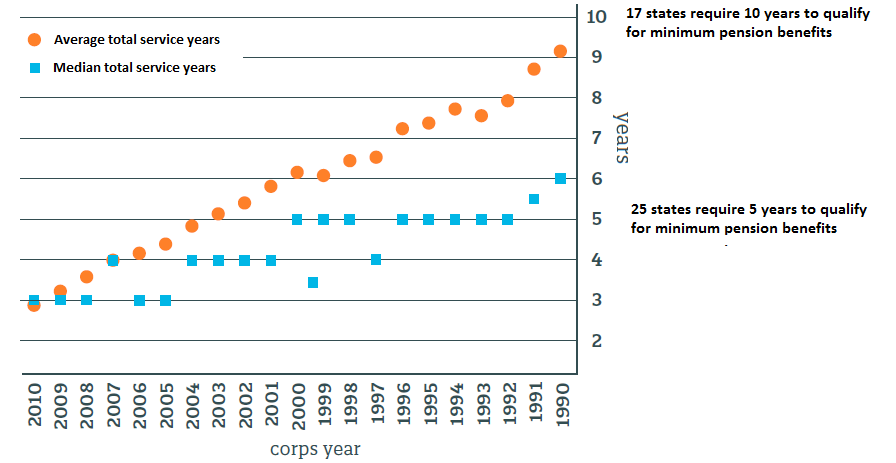
Teach for America celebrates its 25th anniversary this year. An increasing number of alumni are staying in the classroom, and the organization has adopted new policies to recognize this.
Teach for America alumni stay in the profession longer than commonly thought, and those rates are increasing over time. A recent TFA report found that retention rates have increased significantly over time. For example, the percentage of teachers who reported teaching a total of 5 years increased from just 3 percent of the 1990 corps to 23 percent of the 2009 corps. The graph below show the average and median total service years for each TFA cohort from 1990 to 2010. Each set of dots represents corps members beginning in that year.
Source: Raegen Miller and Rachel Perera, “Unsung Teaching,” Teach for America, 2015. Note: n=23,653. Teach for America reports having a 70 percent survey response rate.
State policies, however, still remain out of sync with the needs of teachers—both for Teach for America alumni and the teaching workforce as a whole. In response to massive underfunding, states have passed stricter policies that make it more difficult for new teachers to gain access to adequate retirement benefits. Nationally, the average state now requires teachers to stay at least six years before qualifying for any retirement benefit at all. Forty-five states and the District of Columbia require 5 years or more, and 21 states require 7-10 years. Only five states have a minimum service requirement of four years or less.
So while more teachers are teaching for longer, the majority of teachers still won’t meet qualify for retirement benefits. For TFA teachers, high mobility means that not all of them necessarily taught successive years or stayed in one place; teachers may move across state lines to teach in a different school within their charter network, return to their home state, and/or take a break to raise a family.
But even for teachers who do vest, the odds are stacked against them. Not all pensions are equal, and having some pension doesn’t guarantee it will be a good one. In the median state, teachers need to teach for a minimum of 25 years before “breaking even,” the point where their pensions are finally worth more than their own contributions. Five out of the six original Teach for America regions have break even points of 20 years or more. This means that a teacher who taught in the original 1990 corps--and remained teaching in the same state for the past two decades--will finally be breaking even. Any corps member who doesn’t stay that long will lose out.
In response to these issues, Teach for America has recently taken a bold stance on teacher compensation and retirement benefits, stating:
“Teachers not only need to make competitive salaries, but we need to change compensation structures to reflect modern workplace realities. In particular, in many states, too much of a teacher’s total compensation depends on spending a long time, decades in some cases, in the same school system…Pensions need to be more portable, reflecting the reality that many teachers will not be able, or sometimes willing, to stay in the same place for the duration of their careers.”
Over 11,000 Teach for America alumni remain teaching in the classroom. While they make up only a small fraction of all teachers nationwide, teacher mobility represents a trend in the overall workforce (note: TFA is simply too small to be a significant factor of these national trend).
Teachers are one of the largest class of professionals and need adequate retirement benefits and compensation. It’s time for states to start fostering policies that reflect that.
Note: I was a former Teach for America corps member and taught in Baltimore for three years.
